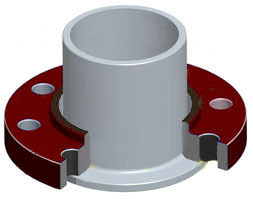
Q: When is it best to use a lap joint flange?
A: Lap joint flanges are good for very expensive materials like tantalum and zirconium and other specialty alloys like Hastelloy or Inconel due to reduced cost of sleeve vs solid flange. Lap joint flanges are unique in that they
are made of two pieces, the flange itself and the stub end. This allows for the flange to be made of a lower cost steel, while only the stub end requires specialty materials.
Lap Joint Flange Uses
Economy
Because a lap joint flange has a two piece configuration, it offers a way to cut cost when piping systems requires a high cost alloy for all “wetted” parts to reduce corrosion. In this situation, it is only required for the stub-end to be can be made of the higher cost corrosion-resistant material, where the flange itself can be the produced from lower cost steel.
Ease of Work
By using lap joint flanges, work can be simplified in situations that require frequent and rapid disassemble and assembly during the operation of a plant. The ability to spin that backing flange compensates for misalignment of the bolt holes during assembly.
Physical Features
Flange
1. The backside, has a slight shoulder that is square cut at the center or pipe hole
2. The front side has a flat face with a filleted (rounded) center hole to match the filleted back face of the stub end. Here the stub end will wrap tightly around the center hole of the flange.

Stub End
1. Shaped like a short piece of pipe with a weld bevel on one. This portion of the stub end is also called the sleeve.
2. Narrow shoulder on the flange facing end called is the hub. The back face of the hub has a rounded transition (or inside fillet) that joins the hub to the sleeve.
